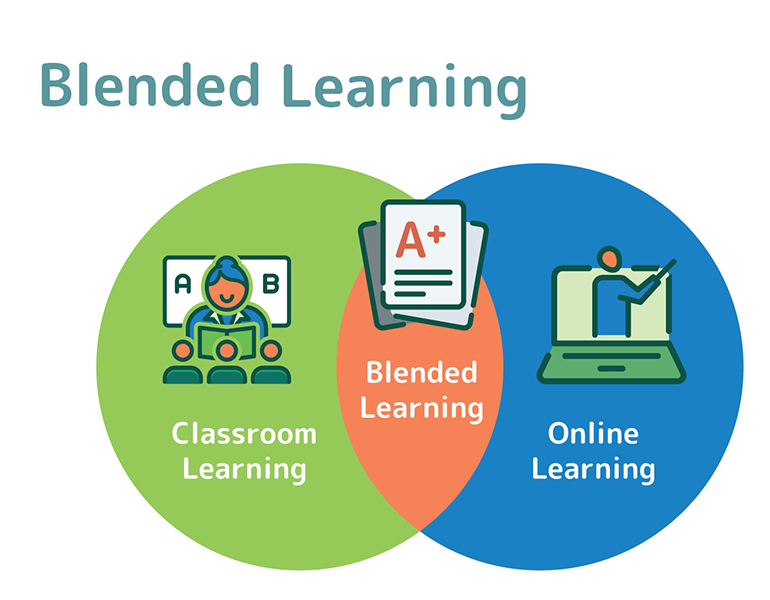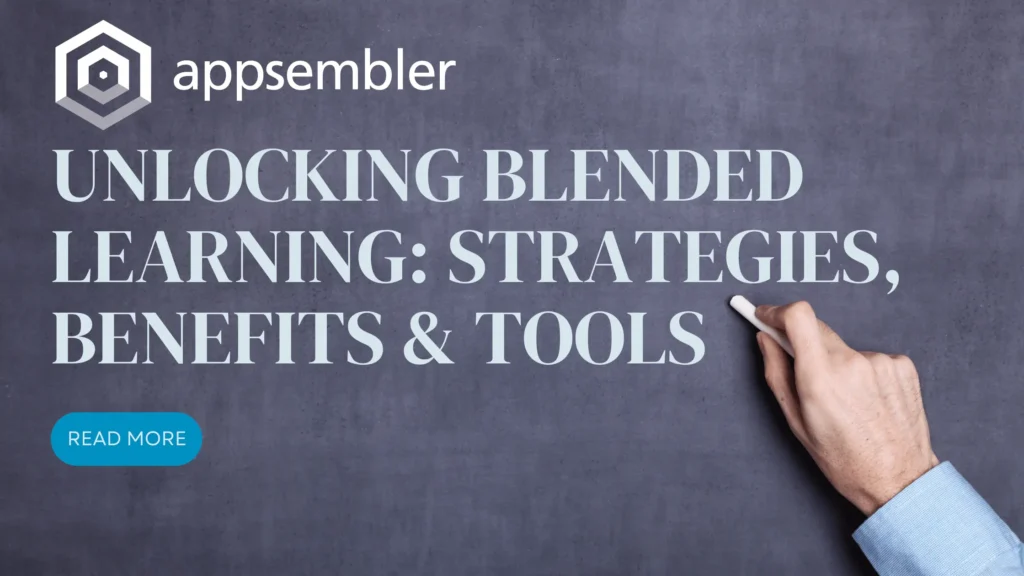Blended learning is transforming education by combining the best of traditional classroom instruction with the benefits of online learning. In this comprehensive guide, we’ll explore the definitions, models, benefits, challenges, and best practices associated with blended learning, and how educators can effectively implement it to enhance the learning experience.
Key Takeaways
- Blended learning is a flexible and personalized approach to education that combines face-to-face instruction with online learning activities.
- There are several blended learning models, including the Face-to-Face Driver Model, Rotation Model, Flex Model, Online Lab Model, Self-Blend Model, and Online Driver Model.
- The benefits of blended learning include personalized learning experiences, increased engagement and retention, flexibility, and enhanced student performance.
- Challenges in blended learning, such as resistance to change and technology barriers, can be overcome through professional development, access to technology, open communication, and adaptive learning tools.
- Best practices for implementing blended learning include establishing clear objectives, incorporating varied instructional strategies, leveraging technology, encouraging student autonomy, and continuously assessing and improving the approach.
Introduction: Exploring Blended Learning
In the world of education, blended learning is a term that’s becoming increasingly familiar. But what exactly does it mean, and why is it relevant now more than ever? At its core, blended learning represents a fusion of traditional classroom instruction and online learning. In the digital age, it offers a dynamic and personalized learning experience that aligns with the evolving needs of today’s students.
Imagine the endless possibilities when you combine the best elements of face-to-face interaction with the limitless resources available online. This powerful combination enables educators to tailor their teaching strategies to suit individual learning styles, thus promoting deeper understanding and engagement. Blended learning provides flexibility, enabling students to access materials and collaborate with peers at their convenience. It’s about striking the right balance between teacher-led instruction and student autonomy.
As we venture further into the 21st century, the importance of embracing blended learning becomes undeniable. The digital revolution is here to stay, and it’s transforming the educational landscape. It’s not just about incorporating technology into the classroom; it’s about harnessing its potential to enhance learning outcomes and prepare students for a future where digital literacy is key.
With the advent of tools like Appsembler, implementing blended learning becomes even more accessible, providing educators with powerful tools to create, manage, and optimize blended learning experiences. Welcome to the future of education, where blended learning takes center stage.
Understanding Blended Learning
Blended learning is a pedagogical approach that integrates the traditional classroom environment with online educational resources. This approach has been around for some time, but it has grown in significance as advances in technology have made it easier to incorporate digital tools into the learning process. Blended learning can be understood as the perfect middle ground between in-person instruction and e-learning. It combines the benefits of both methods, creating a holistic and flexible learning experience for students.

At its core, blended learning brings together two distinct but complementary elements: face-to-face instruction and digital learning. In a blended learning environment, students have the opportunity to interact with their teachers and peers in the classroom and access online resources that can enhance their learning experience. This could include video lectures, online quizzes, digital simulations, and interactive multimedia content.
So why is blended learning becoming so crucial in modern education? As we’ve moved into the digital age, technology has become an integral part of our lives. Today’s students are digital natives, comfortable with using technology to access information and interact with others. By incorporating digital elements into the learning process, educators can better engage with students and meet them where they are.
Moreover, the flexibility that blended learning provides is invaluable. In a traditional classroom setting, students are bound by the constraints of time and place. Blended learning breaks down these barriers, allowing students to learn at their own pace and on their own terms. This flexibility can be particularly beneficial for students with diverse learning needs and preferences.
The importance of blended learning extends beyond the classroom. As the lines between the physical and digital worlds continue to blur, the ability to navigate both is becoming increasingly essential. Blended learning prepares students for a world where digital literacy is just as important as traditional literacy. It fosters a culture of continuous learning and adaptability, skills that are vital in our rapidly changing world.
In conclusion, blended learning is more than just a buzzword. It’s a fundamental shift in the way we approach education, one that recognizes the importance of technology and the need for flexibility in the learning process. It’s an approach that’s relevant, adaptable, and aligned with the needs of today’s students.
Different Approaches to Blended Learning
The versatility of blended learning is seen in its many approaches. Educators have developed different models that serve the specific needs of their students and the logistical requirements of their institutions. Here are six popular approaches to blended learning:
- Face-to-Face Driver Model: This model combines in-person instruction with digital resources. The teacher drives the learning, with online tools serving as a supplement. It’s the closest to traditional education, yet incorporates digital elements to enhance the learning experience. This approach may involve students using online resources to reinforce material discussed in class, to complete assignments, or for further exploration of topics.
- Rotation Model: The Rotation Model divides learning into segments, with students rotating between in-person and online instruction. This rotation can occur on a fixed schedule or be adapted based on each student’s progress. There are several sub-models within the Rotation Model, including Station Rotation, Lab Rotation, and Flipped Classroom. Each variation has its specific sequence of rotating between online and offline learning.
- Flex Model: In the Flex Model, the primary delivery of content and instruction occurs online. Face-to-face time is utilized for personalized support, such as one-on-one tutoring or small group discussions. This approach provides a high degree of flexibility, allowing students to progress at their own pace through the online material while benefiting from in-person support when needed.
- Online Lab Model: The Online Lab Model is where students access the curriculum and instruction online while in a physical classroom or lab setting. This model is often used in schools where there is a lack of qualified instructors for specific subjects. It allows students to take courses online that might not otherwise be available to them.
- Self-Blend Model: In the Self-B lend Model, students supplement their traditional education by taking online courses. This approach is popular in high schools where students might take online courses to access advanced coursework, recover credits, or explore subjects not offered in their school.
- Online Driver Model: In the Online Driver Model, the entire curriculum and teaching are provided online, with face-to-face check-ins. This approach is more common in fully online schools but can be an option for students who need a more flexible schedule or for schools that want to provide additional learning opportunities outside the traditional classroom.
It’s important to note that there is no one-size-fits-all approach to blended learning. The best model will depend on various factors including the needs of the students, the resources of the school, and the goals of the curriculum. Moreover, blended learning models can be customized and combined to create a learning environment that is tailored to the specific needs of the students and the school.
These models represent a shift from traditional, teacher-centered instruction to more student-centered learning. In blended learning environments, students often have more control over their learning, which can be motivating and lead to higher engagement. The incorporation of digital tools allows for a more personalized learning experience, catering to the individual needs and learning styles of each student.
Blended learning is revolutionizing the educational landscape, offering a more flexible, personalized, and efficient way of learning. With the various approaches available, educators can find a model that best suits their classroom and maximizes the benefits of both traditional and digital learning.
Benefits of Blended Learning
Blended learning is transforming the educational landscape, offering myriad benefits for both students and educators. By integrating face-to-face instruction with digital learning, blended learning harnesses the advantages of both traditional and online education.
- Personalized Learning Experiences: In a blended learning environment, educators can tailor the learning experience to the unique needs of each student. Online resources can be customized to accommodate different learning styles, allowing students to interact with content in a way that suits them best. Whether they are visual learners or prefer hands-on activities, students can access material that aligns with their preferences, enhancing their understanding of the subject.
- Increased Engagement and Retention: Blended learning provides an interactive and engaging learning experience. Digital tools such as multimedia content, interactive quizzes, and online discussion forums can captivate students’ attention and immerse them in the learning process. The integration of technology adds a level of novelty and excitement to education, fostering a deeper connection to the material. As a result, students are more likely to retain information, leading to improved learning outcomes.
- Flexibility for Learners and Educators: Blended learning offers a high degree of flexibility. Students can access online resources at their convenience, allowing them to learn at their own pace and revisit material as needed. Educators can adapt their teaching strategies to the progress and needs of their students, offering personalized support and feedback. This flexibility is particularly beneficial for students with diverse learning needs, providing them with the opportunity to succeed in their own terms.
- Bridging the Gap Between Traditional and Online Education: Blended learning offers the best of both worlds. It combines the structure and social interaction of traditional education with the convenience and adaptability of online learning. This fusion creates a learning experience that is relevant, comprehensive, and aligned with the needs of today’s students. It offers a balanced approach to education that prepares students for a future where digital literacy is just as important as traditional literacy.
- Enhancing Student Performance and Outcomes: Blended learning has been shown to enhance student performance. The integration of technology enables students to access a wide range of resources, explore topics in greater depth, and collaborate with peers in innovative ways. The personalized approach allows students to engage with the material in a way that suits their learning style, leading to a deeper understanding of the subject. The flexibility offered by blended learning also enables students to take ownership of their learning, fostering a sense of autonomy and responsibility that can have a positive impact on their academic performance.
Blended learning is revolutionizing the way we approach education. It offers a flexible, engaging, and personalized learning experience that caters to the diverse needs of today’s students. By harnessing the benefits of both traditional and online education, blended learning prepares students for a future where adaptability, digital literacy, and continuous learning are key.
Challenges and Solutions
Blended learning, while innovative and effective, presents its own set of challenges. Understanding these obstacles and their solutions is key to the successful implementation of a blended learning approach.
- Overcoming Resistance to Change: Transitioning to blended learning can be met with resistance from educators and students alike. It’s a shift from the traditional teaching methods many are accustomed to. The solution is to offer professional development and training for educators, and orientation sessions for students. Encouraging a culture of adaptability and lifelong learning can also help ease the transition.
- Navigating Technology Barriers: Not all students have access to the necessary technology for online learning, creating a digital divide. Schools can overcome this by providing devices, creating technology hubs, or partnering with local organizations to offer students access to digital resources. Ensuring that all students can access the technology they need is crucial for the success of a blended learning program.
- Ensuring Effective Communication: In a blended learning environment, clear communication between educators and students is crucial. Online platforms can sometimes create a sense of disconnect. Encouraging open dialogue, setting clear expectations, and providing regular feedback can help bridge this gap. Tools like discussion forums, virtual office hours, and chat features can facilitate communication.
- Maintaining a Balance Between Online and In-Person Instruction: It’s important to strike the right balance between online and in-person instruction. Educators should ensure that digital tools complement, rather than replace, face-to-face interactions. Blended learning models, such as the Rotation Model, can help maintain this balance.
- Addressing Individual Learning Needs: In a blended learning environment, it can be a challenge to cater to the diverse needs of all students. Adaptive learning technologies can be a solution. These tools can adjust the content and resources to the learning preferences and pace of each student. Additionally, teachers can use the data from these tools to provide more targeted support.
While blended learning comes with challenges, they are not insurmountable. With the right strategies and tools in place, these obstacles can be overcome, allowing schools to harness the full potential of blended learning. As we navigate the ever-evolving landscape of education, embracing innovative approaches like blended learning can pave the way for more inclusive, engaging, and effective learning experiences.
Best Practices for Implementing Blended Learning
Blended learning is a flexible, innovative approach to education that can greatly benefit both educators and students. However, its successful implementation requires careful planning and consideration. Below are some best practices for implementing blended learning:
- Establishing Clear Objectives: It’s important to start with a clear understanding of what you want to achieve with blended learning. Are you aiming to increase student engagement, offer a more personalized learning experience, or improve learning outcomes? By establishing clear objectives, you can tailor your blended learning approach to meet your specific goals.
- Incorporating Varied Instructional Strategies: In a blended learning environment, it’s crucial to use a mix of instructional strategies. Incorporate lectures, discussions, hands-on activities, group work, and online resources to cater to different learning styles. By varying your instructional strategies, you can create a more engaging and effective learning experience.
- Leveraging Technology to Enhance Learning: Technology is a key component of blended learning. Use digital tools to enhance the learning experience, such as multimedia content, interactive quizzes, and online discussion forums. Incorporate technology that aligns with your objectives and supports your instructional strategies. Remember, technology should complement, not replace, face-to-face instruction.
- Encouraging Student Autonomy and Accountability: Blended learning offers students greater flexibility and control over their learning. Encourage students to take ownership of their education by setting goals, managing their time, and seeking help when needed. Foster a sense of accountability by setting clear expectations and providing regular feedback.
- Continuously Assessing and Improving the Blended Learning Approach: Implementing blended learning is an ongoing process. Continuously assess the effectiveness of your approach by gathering feedback from students, analyzing performance data, and reflecting on your own experiences. Use this information to make adjustments and improvements to your blended learning approach.
Blended learning offers a wealth of benefits, but its successful implementation requires careful planning and consideration. By establishing clear objectives, incorporating varied instructional strategies, leveraging technology, encouraging student autonomy and accountability, and continuously assessing and improving your approach, you can create a blended learning environment that is engaging, effective, and tailored to the needs of your students. As the educational landscape continues to evolve, embracing innovative approaches like blended learning can help educators and students alike thrive in this ever-changing world.
Appsembler’s Role in Supporting Blended Learning
Appsembler is an industry-leading learning management system (LMS) that plays a vital role in supporting blended learning. It offers an array of features designed to streamline and enhance the online component of a blended learning approach, making it a valuable tool for educators and institutions.
Appsembler’s platform provides a user-friendly, customizable interface that allows educators to create and manage online courses with ease. Its diverse suite of tools includes multimedia content integration, interactive assessments, and collaboration features like discussion forums and group workspaces. These tools empower educators to deliver engaging and interactive online learning experiences that complement and enrich their in-person instruction.
One of the key challenges in blended learning is the seamless integration of technology. Appsembler addresses this issue by offering robust integrations with popular software applications, allowing educators to incorporate a wide range of digital resources into their courses. Its platform also supports multiple languages, making it an ideal solution for global institutions.
Appsembler also assists with the implementation of blended learning by providing comprehensive training and support for educators. Its team of experts offers guidance on best practices for blended learning, helping educators design and deliver effective online components that align with their objectives.
A case study illustrating Appsembler’s impact on blended learning is the successful partnership with Pennsylvania State University. The university was struggling to engage students in its online courses and turned to Appsembler for assistance. Appsembler’s team worked closely with the university to redesign the online component of its blended learning courses, incorporating interactive multimedia content and assessments. As a result, the university saw a significant increase in student engagement and satisfaction with the online portion of their blended learning courses.
In conclusion, Appsembler plays a crucial role in supporting blended learning by providing a powerful LMS that enables educators to deliver engaging and interactive online learning experiences. Its platform, combined with its expert training and support, make it an invaluable tool for institutions looking to implement and optimize a blended learning approach. Appsembler’s success in enhancing blended learning is evident in its successful partnerships with institutions like Pennsylvania State University, highlighting its positive impact on the field of education.
Conclusion: The Future of Blended Learning
Blended learning is more than a trend; it’s a revolution in education that offers a balanced approach, combining the best of traditional classroom instruction with the advantages of online learning. As technology advances and becomes more accessible, blended learning will continue to evolve, offering even greater possibilities for educators and learners alike.
The future of blended learning is poised to be even more personalized, adaptive, and flexible. With the increasing use of AI and machine learning, educators will be able to tailor learning experiences to individual student needs and preferences even more effectively. As technology continues to evolve, we’ll see an increasing number of tools designed to enhance the blended learning experience, making it even more engaging and interactive.
Moreover, the lessons learned during the global pandemic have emphasized the importance of adaptability in education. Blended learning offers the flexibility to adjust to changing circumstances, whether that be a global crisis or simply the diverse needs of individual students.
The future of education is blended, and it’s a future that promises greater accessibility, engagement, and achievement for all. As we continue to explore the potential of blended learning, we are shaping a brighter, more inclusive future for education.
Frequently Asked Questions
Blended learning is an approach to education that combines traditional classroom instruction with online learning. It offers a more flexible and personalized learning experience, catering to different learning styles and enabling students to learn at their own pace. It’s important because it enhances student engagement, allows for more individualized instruction, and prepares students for a technology-driven world.
Blended learning works by integrating face-to-face instruction with online learning activities. The online component can include multimedia content, interactive assessments, and collaboration tools. The specific blend of online and in-person instruction can vary depending on the model chosen. The goal is to create a more engaging and flexible learning experience that caters to individual student needs.
There are several models of blended learning, including the Face-to-Face Driver Model, Rotation Model, Flex Model, Online Lab Model, Self-Blend Model, and Online Driver Model. Each model offers a different balance between online and in-person instruction, and the choice of model depends on the specific goals and needs of the educators and students.
Blended learning offers numerous benefits, such as personalized learning experiences, increased engagement and retention, flexibility for learners and educators, bridging the gap between traditional and online education, and enhancing student performance and outcomes. By combining the best of both worlds, blended learning creates a more engaging, effective, and adaptable learning environment.
Blended learning can present challenges, including resistance to change, technology barriers, communication difficulties, balancing online and in-person instruction, and addressing individual learning needs. These challenges can be overcome by offering professional development and training, providing access to technology, encouraging open communication, using blended learning models to maintain balance, and incorporating adaptive learning technologies.
Appsembler is a learning management system that supports blended learning by providing a user-friendly platform for creating and managing online courses. Its features include multimedia content integration, interactive assessments, and collaboration tools. Appsembler also offers training and support for educators, helping them effectively implement blended learning. Institutions like Pennsylvania State University have successfully used its platform to enhance their blended learning approach.


